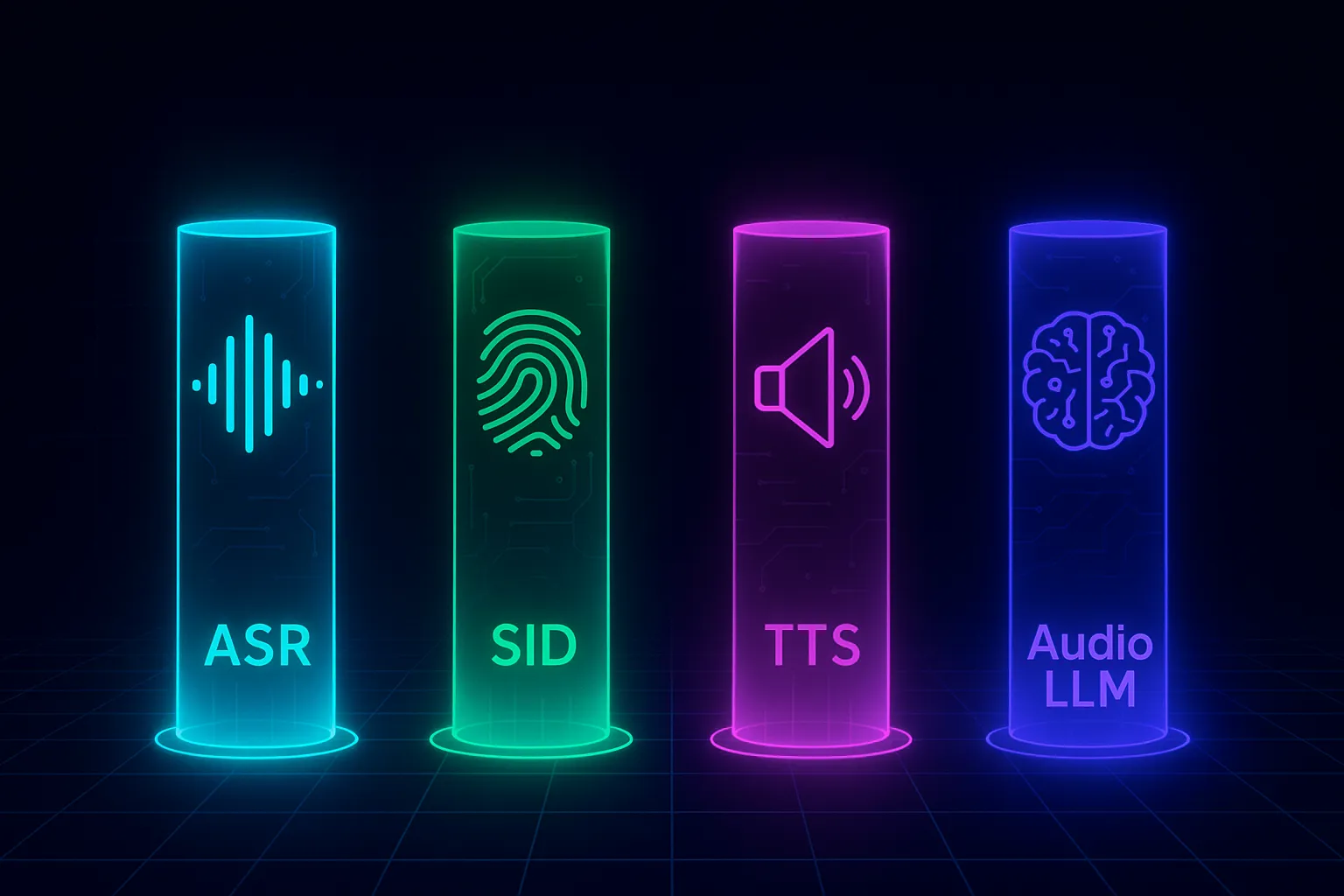As voice becomes a primary interface for interacting with machines, adversarial threats against speech AI systems are growing rapidly and quietly. From spoofing speaker identity to injecting imperceptible noise that breaks transcription, the attack surface is broad and evolving. In this post, we’ll outline the core types of speech models, how they’re vulnerable, and why securing Audio LLMs may be the next major frontier in AI defense.
The Four Pillars of Modern Speech AI
To understand where threats emerge, we first need to define what we’re protecting. Most speech AI systems fall into one of four categories:
- Automatic Speech Recognition (ASR) – Converts speech into text for assistants, transcription tools, and voice interfaces. Vulnerable to injected noise or phrasing that misleads transcription (e.g., command injection).
- Speaker Identification (SID) / Verification) – Maps a voice to a speaker’s identity. Common in authentication systems and forensics. A prime target for spoofing and voice cloning.
- Text-to-Speech (TTS) / Speech Synthesis – Converts text into synthetic speech. Attackers can manipulate training data or fine-tuning pipelines to produce malicious or misleading output.
- Audio LLMs (Speech-to-Speech models) – The newest and most complex systems. These models understand, reason, and respond in audio, effectively, LLMs that operate directly on waveforms. The attack surface is vast, and many defenses from text-based LLMs do not yet apply.

Threat Models: White, Gray, and Black Box
In adversarial ML, how much an attacker knows matters:
- White-box attacks – The attacker has full access to the model architecture and weights. These are the most effective and often used in academic research to stress-test models.
- Gray-box attacks – The attacker knows partial information — maybe the training data format or the model family — but not internals. For example, in ASR, they may know the system is based on Whisper or a Conformer architecture.
- Black-box attacks – The attacker sees only inputs and sometimes outputs, without access to model internals. These are more common in deployed systems (e.g., calling a voicebot or querying an API), where attackers can observe how outputs change in response to their probes and use that feedback to refine transfer-based or query-efficient attacks.
Each threat model enables different strategies — from crafting precise adversarial audio to probing systems with subtle manipulations to bypass detection or impersonate a target.
Targeted vs. Untargeted Attacks
Understanding attacker goals is just as important as understanding their level of access.
Another critical axis is intent:
- Targeted attacks aim for a specific output, like tricking a voice authentication system into recognizing a particular person.
- Untargeted attacks aim to degrade the system’s performance or cause unpredictable behavior (e.g., making an ASR model mishear critical instructions).
Both are dangerous. The former can result in identity theft or fraud. The latter can create chaos, mistrust, or operational failure.
Crafting an Adversarial Attack (At a High Level)
In speech, adversarial examples are usually carefully perturbed audio samples that sound natural to humans but cause the model to break.
For example, a one-second background noise can cause an ASR system to mis-transcribe “do not execute” as “execute.” Or a synthesized impersonation can bypass a voice biometric check entirely.
These attacks are no longer just academic. Open-source toolkits built specifically for speech-based adversarial research, such as AudioTrust, are now making it possible to generate and test adversarial examples across tasks like ASR and speaker verification. AudioTrust supports white-box and black-box attack evaluations and includes built-in perturbation tools and evaluation metrics for voice-specific models.
Additionally, modern attack methods like universal perturbations and transfer learning allow attackers to target systems even when they haven’t trained the model themselves, making them more dangerous in black-box settings. Some even use reinforcement learning techniques to optimize attacks over multiple queries, gradually learning how to break the system with higher confidence.
Take, for example, a scenario where an attacker uses subtle audio perturbations to manipulate a real-time voice agent, such as a customer service bot or an AI-based virtual assistant. These perturbations could alter intent recognition or trigger a misrouted action, like transferring funds, leaking personal information, or escalating to a fraudulent workflow. Or consider a multilingual voice interface being subtly manipulated during a support call, where translation shifts result in misunderstood terms or incorrect service confirmations, leading to customer dissatisfaction or liability exposure.
Why Audio LLMs Will Become the Frontline of Speech Security
This next generation of voice models opens exciting possibilities — and massive new risks.
Everything we’ve learned about securing LLMs, from prompt injection defenses to token filtering and sandboxed response validation, will need to be rethought and reapplied in the audio domain. Audio LLMs are fundamentally token-based models like their text counterparts, but they process waveforms, not words. That means the same attacks aimed at semantic control, output hijacking, or hidden prompt triggers now take place within the audio signal, making them harder to detect and more sensitive to adversarial noise.
The rise of conversational AI, especially agents that understand and respond in real-time, is accelerating. With speech-to-speech models like Audio LLMs, the complexity of the attack surface increases dramatically.
Here’s why securing them is urgent:
- Conversational AI is scaling – Enterprise and consumer apps are moving from text to multimodal and voice-first experiences.
- Speech-to-speech is the natural interface – Audio LLMs will power assistants, translators, agents, and more , all operating in real-time.
- Traditional defenses don’t transfer – Prompt filtering and output constraints aren’t enough. Audio models are vulnerable to signal-level, identity-level, and interaction-level manipulation.
We’re at the beginning of this shift, and as Audio LLMs become the core engine for speech intelligence, adversarial security must evolve alongside.
Conclusion
We’re entering an era where voice is no longer just a medium for interaction — it’s a target, a tool, and a liability all at once. Adversarial attacks against speech AI are already here, and they’re growing more capable. From targeted impersonation to model confusion, each layer of the speech stack presents a new opportunity for abuse.
These attacks will affect trust, context, and the integrity of real-time human-machine interaction.
As the space evolves toward Audio LLMs and real-time voice agents, security must shift from reactive detection to proactive protection, defending both the signal and the semantics of speech.
Organizations should begin by::
- Modeling threat exposure across tasks like ASR and SID.
- Evaluating voice-anonymization and Audio-AI defenses.
- Building internal awareness of speech-model vulnerabilities.
The goal isn’t just to make speech AI smarter—it’s to make it trustworthy under pressure.
Ready to secure the future of voice? If you’re tackling similar challenges or want to explore how Apollo Defend can safeguard your speech-AI stack, drop us a note at info@apollodefend.com. Let’s strengthen the audio frontier together.

 Yishay Carmiel
Yishay Carmiel
